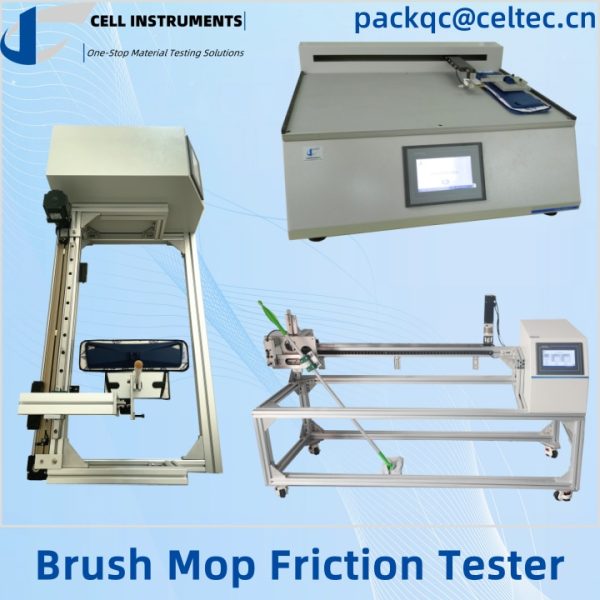Comprehensive Guide to Brush Mop Friction Tester for Quality Control
Ensuring that cleaning materials such as mops are effective and durable is essential. Manufacturers, especially those in the home and industrial cleaning industries, must ensure their products are of the highest quality. The Brush Mop Friction Tester plays a critical role in assessing the friction properties of these materials, ensuring they meet stringent performance standards. This article explores the functionality, significance, and benefits of using a Brush Mop Friction Tester, focusing on testing the coefficient of friction for mop materials.
Importance of Friction Testing for Cleaning Materials
The coefficient of friction (COF) measures the resistance encountered when one surface slides over another. In the context of cleaning tools like mops and brushes, friction is a key factor in determining how effectively they can clean surfaces. By measuring the coefficient of friction for mop materials, manufacturers can better understand how their products will perform in real-world conditions. A mop that generates too much or too little friction might not clean effectively, potentially leaving behind dirt or causing unnecessary wear.
Features of the Brush Mop Friction Tester
The Brush Mop Friction Tester developed by Cell Instruments is designed to provide precise and reliable friction measurements for cleaning materials. Some of its core features include:
- 7-inch HMI Touchscreen: The easy-to-use interface allows users to control all testing parameters efficiently.
- PLC Industrial Control System: Ensures stable and reliable testing processes, which are critical for consistent results.
- High-Precision Loadcell: With an accuracy of 0.5% FS, this load cell provides exact friction data, helping manufacturers make informed decisions.
- Adjustable Testing Speed: Capable of testing at speeds from 1 to 60,000 mm/min, the tester can simulate various real-world cleaning conditions.
- Real-Time Data Display: The machine shows friction data as the test is performed, allowing users to monitor the material’s performance continuously.
Why Evaluate the Coefficient of Friction for Mop Materials?
Measuring the coefficient of friction for mop materials helps companies determine how effective their cleaning tools will be on different surfaces. A mop that performs well on a smooth floor may not be as effective on textured tiles, and the friction properties will influence this. Understanding these dynamics allows manufacturers to fine-tune their products for optimal performance.
Moreover, testing helps identify weaknesses in materials that might cause mops to wear out faster or fail in tough cleaning environments. By optimizing friction properties, manufacturers ensure their products deliver the best cleaning performance while extending the tool’s lifespan.
Testing Procedure for the Brush Mop Friction Tester
To use the Brush Mop Friction Tester, follow these steps:
- Prepare the Sample: Secure the mop or cleaning material in the tester’s holder, ensuring it is positioned correctly.
- Set Testing Parameters: Using the HMI touchscreen, adjust the desired testing speed, cycle count, and applied pressure.
- Begin the Test: The machine will simulate the cleaning motion, measuring the friction force at various stages.
- Monitor Data: Real-time friction data is displayed during the test, allowing you to observe any performance variations.
- Analyze Results: Once the test cycle completes, review the friction data to assess the mop’s performance under different cleaning conditions.
Benefits of the Brush Mop Friction Tester
The Brush Mop Friction Tester offers several key benefits for manufacturers:
- Enhanced Product Quality: By understanding how mops perform under different conditions, companies can improve their product designs for better cleaning efficiency.
- Cost-Effective: Identifying performance issues early in the production process reduces waste and increases overall production efficiency.
- Improved Customer Satisfaction: A well-tested product is more likely to perform reliably, leading to higher customer satisfaction and reduced returns.
- Support for Innovation: Friction data can reveal new opportunities for product improvement, helping companies stay competitive in the cleaning industry.
Applications Across Industries
The Brush Mop Friction Tester is versatile and can be used in various industries, including:
- Household Cleaning Products: Ensure that mops and brushes used in home cleaning are effective on different types of surfaces.
- Industrial and Commercial Cleaning: Test high-performance cleaning tools designed for industrial spaces and large-scale operations.
- Medical and Pharmaceutical: Evaluate cleaning tools used in sensitive environments to ensure they meet hygiene and safety standards.
- Packaging and Textiles: Assess the friction and cleaning efficacy of materials used in packaging and textile cleaning.
Why Choose Cell Instruments’ Brush Mop Friction Tester?
At Cell Instruments, we offer customized solutions for clients with unique testing requirements. Our Brush Mop Friction Tester can be tailored to specific testing protocols and cleaning scenarios, ensuring it meets the demands of different industries. Whether you’re testing mops for household use or industrial-grade cleaning materials, this versatile and precise machine delivers reliable results.
FAQ Section
1. What is the purpose of testing the coefficient of friction for mops?
Testing the friction helps evaluate how effectively a mop will clean different surfaces. It ensures that the mop generates the right amount of friction for efficient cleaning.
2. How does the Brush Mop Friction Tester work?
The tester measures the friction force as the mop moves across various surfaces, providing real-time data on how the cleaning material performs under different conditions.
3. Can the Brush Mop Friction Tester be customized?
Yes, Cell Instruments offers customization options for the tester, including software, fixture, and program customizations to meet specific testing needs.
4. What industries benefit from using the Brush Mop Friction Tester?
Industries such as home cleaning, industrial cleaning, medical and pharmaceutical, and packaging benefit from using the tester to ensure their cleaning tools are effective.
5. How does friction testing improve mop design?
By analyzing friction data, manufacturers can optimize their products for better performance, durability, and customer satisfaction.
Related Products
Related Article
Mop Coefficient of Friction Tester
Reference

